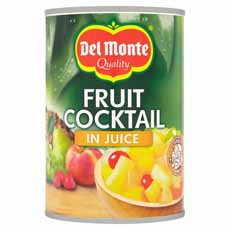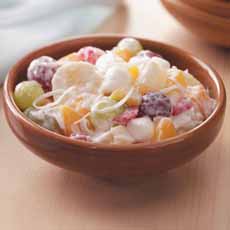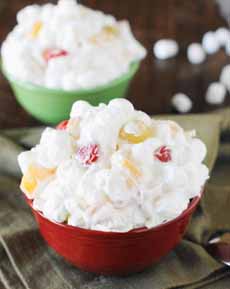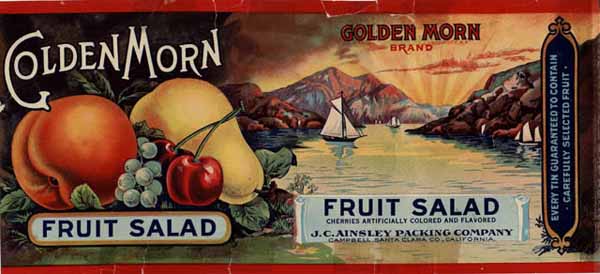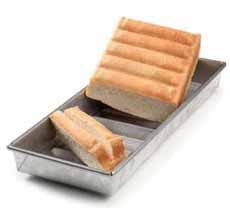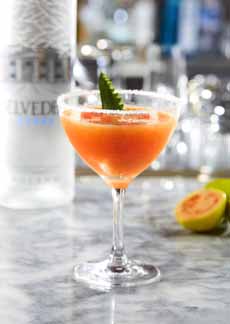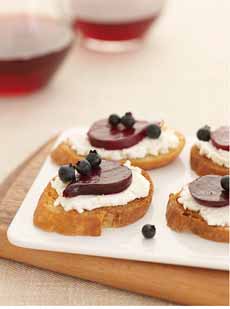
[1] Pickled beets and blueberries on goat cheese crostini (photo courtesy Rick’s Picks).

[3] Pickle radishes and layer sour with spicy (here’s the recipe from Simple Delicious Food).
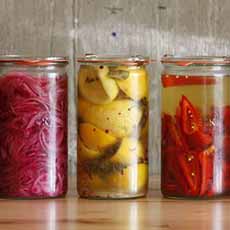
[2] Pickle any fruit or vegetable you like (photo courtesy Typhoon).
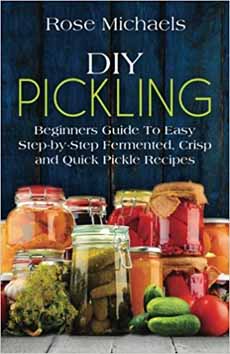
Basic pickling is easy (here’s how). But if you want ideas on how to layer herbs and spices, get a book like this.
|
|
Pickles and sauerkraut have been consumed in America for centuries, along other sour foods such as buttermilk, sour cream, sourdough bread, vinegar, and tart fruits like grapefruits, kumquats, lemons and limes.
But sour has grown even more in favor over the past few decades with kefir, kimchi, kombucha, plain yogurt, tamarind and tart cherry juice becoming everyday foods.
This week, Flavor And The Menu, a magazine and website for creative chefs, highlights how chefs nationwide are using the humble pickle.
And by pickle, we mean pickled anything. In the U.S. “pickles” evokes pickled cucumbers; but elsewhere in the world, any pickled vegetable is a “pickle.”
And, happy news: You can pickle anything in an hour. These are called quick pickles, but you can leave them in the brine as long as you like (days, weeks…).
Our favorite things for quick pickling: apples, asparagus, beets, carrots, cauliflower, green beans, onions and pears. And for burgers and sandwiches, garlic cloves.
NEW WAYS TO USE PICKLES
1. PAIRED WITH CHICKEN
With the continued popularity of fried chicken, chefs have paired pickles as a flavor strategy. The subtle sour contrast complements anything fried or fatty (that’s why cornichons are paired with pâté).
Beyond pickled vegetables with chicken, Fellow restaurant in Los Angeles serves buttermilk and pickle juice-brined chicken sandwiches paired with aged cheddar, oven-roasted tomato, dill pickles and iceberg lettuce on sourdough bread.
2. PICKLED FRUITS
Our taste buds love the counterbalance of sweet and sour. Creative kitchens are now brining any and all fruits, from berries to apples and pears to mangos and melons.
Taiwanese-American restaurant Win Son in Brooklyn tops its butter-grilled shrimp cake with pickled pineapple, layered on a mian tuan bun.
3. SPREADS & DIPS
Adding a tangy element to a creamy dip or spread adds an extra hit of flavor on burgers, fish sandwiches or anything fried.
At Wilshire restaurant in Santa Monica, California, pickled aïoli is slathered on the brioche burger bun, adding special flavor to the cheeseburger layered with aged cheddar, caramelized onions and house-made pickles.
4. VEGETARIAN
Consumer demands for more plant-based dishes has led to innovation on the menu. Pickling offers a major flavor boost to vegetarian menu items.
At Bar Annicka in Brooklyn, the entrée of charred cauliflower is accompanied by a pickled beet pâté, blackened cabbage and garlic confit.
5. SURPRISING HITS OF FLAVOR
Adding a pickled ingredient where one might not expect it is one of the charms of accenting with pickles.
Freebird Kitchen & Bar in White Plains, New York serves a side dish of roasted Brussels sprouts with pickled shallots, for a surprising spike of flavor.
6. THE CRUDITÉ PLATE
Crudité platters have been advanced with everything from baby vegetables to unusual varieties: They are now joined by pickled vegetables.
In fact, Canon restaurant in Sacramento serves an entire pickled crudité plate: a variety of house-pickled seasonal veggies served over crushed ice.
7. THE CHEESE PLATE
The sourness of pickles complements the fattiness of cheese. Take the tip from the previous tip and serve pickled vegetables with your cheese plate.
|
8. COCKTAIL PICKLES
Pickle juice adds a modern tang to cocktails. The White Heat, served at Jordan Hotel’s Sliders in Sunday River, Maine, combines cucumber-infused vodka, pickle juice, peppadews and olives.
9. ICE CUBES
We’ve long advocated pickle slices in ice cubes for Bloody Marys, and saving pickle brine to freeze into ice cubes.
Pickles are becoming more of a player on restaurant drink menus. The flavors of pickle brine provides a slow melt of sour, as at Milk Money Bar & Kitchen in Ft. Lauderdale, Florida.
You don’t need to make the ice cubes of 100% pickle juice. In fact, try that to see if it’s too strong for you.
Instead, make the cubes one-third or one-half pickle juice.
And if you find yourself wanting to do more and more pickling, get a book!
We don’t have the time or space to “put up” pickles in jars, but we do make quick pickles every week.
|
